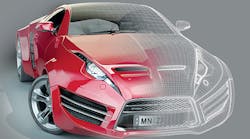Taking Digital Twins for a Test Drive with Tesla, Apple
If you’re reading this on an iPhone, your phone is likely capturing data and sending it to Apple for analysis. With every tap and swipe across the billions of iPhones in the world, Apple has a better understanding of which software components are working smoothly and which aren’t. Every few weeks, Apple applies the insights it gains from this data to update the software across every device in use.
As you know, Apple isn’t the only one doing this—the practice is common throughout the tech world. Extensive data capture and analysis are part of the reason Apple and others have been able to release incrementally better products every year for over a decade.
Now, imagine if the practice of continuously capturing performance data and applying it to product development was applied to every product. This is the ultimate goal of the Internet of Things (IoT) and digital twins.
Digital twins are detailed, data-driven digital representations of products in the field. As more products come equipped with sensors, manufacturers gain the ability to collect data in the digital twin, enabling real-time analysis of product performance and conditions. By aggregating data from the digital twins of all their products in the field, manufacturers can gain performance insights at a scale not unlike that of iPhones and other consumer electronics.
Forward-thinking manufacturers are already doing this. Case in point, Tesla creates a digital twin of every vehicle it sells. Sensors from thousands of cars continuously stream data into each car’s simulation in the factory, where Artificial Intelligence (AI) interprets the data and determines whether a car is working as intended or if it needs maintenance. For many maintenance issues, Tesla’s software integrations are so thorough that problems can be fixed with software updates—for instance, adjusting the hydraulics to compensate for a rattling door. By merging AI and IoT, Tesla is able to constantly learn from the real world and optimize each of its cars individually, in real time.
Tesla is a great model for what is possible when a digital-twin approach is baked into product development and manufacturing. But what if digital twins could go beyond predictive maintenance and software updates? What if, on top of optimizing products in the field, digital twins could be used to optimize the design of future products? This could soon be possible with generative design.
Generative design is an evolving Computer Aided Design (CAD) technology where AI is applied to optimize mechanical designs for the goals specified by the designer. As it currently works, product designers manually specify the material properties, boundary conditions and forces expected to act on the part at its points of contact. AI then optimizes the design for the parameters set by the designer. When combined with digital twins, generative design can optimize designs based on the real-world conditions of the product in the field.
Aggregating the live data from thousands of products in the field, digital twins can simulate the performance and conditions faced by the average product over its entire lifetime, with real-world accuracy. Armed with this data, generative design AI could then serially tweak the product design and simulate its lifetime performance under real-world conditions until it arrives at the best solution that satisfies the designer’s goals.
With high-performance cloud computing, a wide range of goals can be optimized for with generative design. Depending on the product, part, or use case, the designer could use AI to optimize their part to extend lifetime, maintain strength, reduce weight, stay within a heat transfer threshold, or limit drag. Designs can also be optimized for different manufacturing techniques, enabling manufacturers to create designs that can be manufactured with the equipment they already have, whether it be casting, milling, or extrusion.
But generatively optimizing parts for manufacturing is perhaps most valuable when optimizing for additive manufacturing. The most efficient generative designs are often made up of complex organic geometries that are difficult to manufacture without additive manufacturing. Additive manufacturing also offers extra flexibility, allowing on-demand printing without significant retooling.
One can imagine a scenario where a motorcycle manufacturer follows Tesla’s model and equips their motorcycles with dozens of sensors connected to digital twins. When a part breaks on a bike, the driver takes it into the shop to get it fixed, where the performance data in the bike’s digital twin can inform a generatively designed replacement part, tailor-made for that bike. Instead of ordering a replacement part and waiting for it to arrive, the shop can 3-D-print the generative replacement part that day.
The examples this article cites may have been limited to vehicles, but generative design and digital twins can work in harmony to improve industrial designs across industries — from wind turbines all the way to entire buildings. In an architectural setting, the structural components of a skyscraper could be equipped with sensors to measure the impact following an earthquake. With generative design, this data can be used to build stronger skyscrapers in the future.
Product development has always been driven in part by analysis of existing products. As IoT sensors become more widespread, digital twins and generative design will empower manufacturers to understand the performance of their products at an unprecedented scale and automatically apply these insights to build better products, accelerating the pace of innovation.
Jesse Coors-Blankenship is the senior vice president of technology at PTC.




